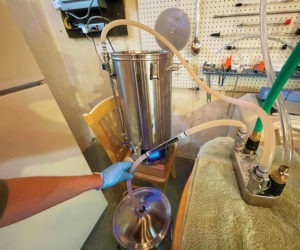Build a Draft Jockey Box

For those who don’t already know what it is, a jockey box is a “just-in-time” beer chilling and dispensing rig made from an insulated cooler, a coil of metal tubing, and standard draft dispensing hardware. The jockey box is packed with ice (and a little water) to get the coil cold. Beer is pushed from the keg into the jockey box, which cools the beer as it travels through the chilled metal and is then dispensed through a standard draft faucet. This allows for temperature-correct draft beer to be served in any place where electric refrigeration is not convenient or possible, such as a camping trip.
Commercial jockey boxes are often made using a plate chiller to cool the incoming beer. These are very efficient chillers, and somewhat similar to the wort plate chillers used in commercial and homebrewing. As you might expect, these chillers are not cheap, and so our jockey box project will use more common metal tubing – stainless steel (although it can be built with copper as well), which is available at most hardware stores.
Stainless steel is the metal of choice for this project as finished beer comes in contact with the metal. Many homebrewers build jockey boxes with copper tubing as copper is amazingly efficient at heat transfer (it has tremendously high thermal conductivity). It is great for any project related to chilling, such as immersion chillers, however copper can be the source of some negative consequences when it comes in contact with finished beer, which has a different pH than wort. Copper has the potential to cause staling post-fermentation because it catalyzes staling reactions, including the production of hydrogen peroxide and can oxidize the alcohols to aldehydes. There is also potential for copper to lead to copper poisoning (nausea, vomiting) from too much exposure. If you don’t want to worry about it, go with stainless steel — it’s more expensive and harder to bend, but non-reactive.
Tools
• Drill with 7⁄8-inch hole saw
• Rotary tool (Dremel) or hack saw with metal cutting blade
• Adjustable wrench
• Flathead screwdriver
Parts
•Insulated cooler (the size will depend on how many taps you plan to add. For a single tap, the cooler can be very compact.)
• 2x Beer shanks — one for beer in to the box; one for beer out.
• 3x Shank nuts
• Wing nuts and tail pieces, as needed
• Dispensing faucet
• 20 feet of pre-bent stainless steel tubing: 1⁄4-inch OD
• 1 foot (approximately) of vinyl tubing: 3⁄8-inch OD
• Hose clamps
• Teflon pipe tape



